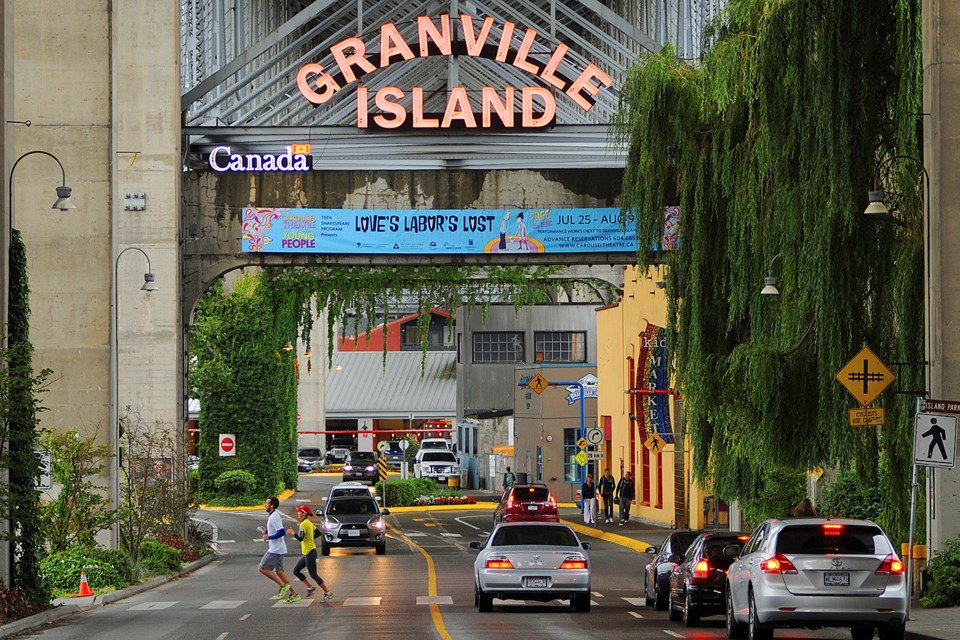The federal government launched a planning initiative Friday to have the public, merchants and others weigh in on what they want Granville Island to look like by 2040.
The goal of the exercise is to establish development plans for the soon-to-be-vacant Emily Carr University buildings, potential revitalization of the public market and improvements for the arts and culture industry on the island.
The addition of housing is also a possibility.
“It’s a plan to articulate and to look at the future of Granville Island for the next 25 years,” said Dr. Hedy Fry, Liberal MP for Vancouver-Centre, who made the announcement on behalf of Jean-Yves Duclos, the federal minister responsible for Canada Mortgage and Housing Corporation (CMHC), which manages the island.
In her opening remarks from a patio at Bridges Restaurant, Fry described the island under the Granville Bridge as a jewel in Vancouver’s crown, having transformed 40 years ago from a gritty abandoned industrial area into a vibrant, accessible multi-use public space.
When asked by the Courier why the island needs to transform again, Fry said: “Everything has to change. I’ve talked many times to the stakeholders who live here, who work here and they have huge dreams for this place.’
Overseeing those dreams will be Dr. Michael Stevenson, president emeritus and vice-chancellor of Simon Fraser University, who will lead the project on behalf of the CMHC.
An advisory board and the Granville Island Trust will help guide the process and decisions of the plan, which will also determine the best governance structure for the island.
The move to develop a 2040 plan comes more than a decade after the CMHC began to create a similar plan for the island. But, Stevenson said by telephone Friday, it was never completed.
“Some planning was done between 2005 and 2008, and I think it was the intention originally that a formal plan would be produced and made public by CMHC,” he said. “For reasons that are obscure to me, that never came to be.”
Stevenson said he agreed with Fry’s description of the island as a jewel. He said it was a success story in Canadian urban planning and the property is much loved by Vancouverites and tourists. But, he added, inevitably after 40 years they are “aging issues that need attention.”
“There are a number of infrastructure maintenance issues, there are traffic management issues, there is transit connectivity as a continuing problem and there have been changes in the 40 years that have meant the competitive landscape for commercial enterprises, especially the food market, has changed markedly,” he said. “But nobody wants to re-invent the wheel or fix something that isn’t broken. That’s for sure.”
He also noted there’s been a migration of arts and cultural activity from the island, including the pending move of Emily Carr University of Art and Design to a new campus on Great Northern Way in 2017.
A key to finalizing the plan, which is expected to be completed by the end of the year, will be to create a vision for land use and arts and culture on the island. A request for proposals to hire consultants will be issued May 9.
Asked about whether he believed affordable housing would be a component of the plan, Stevenson pointed out the original reference document to transform the island including some housing. None was ever built.
“It remains an open question,” he said.
But, he added, given the concerns of many residents about the massive growth of Vancouver in recent years, particularly with highrises downtown, he doubted that type of development would be included in the plan.
“I’m certain, that given the commitment to respect the history and character of the island, that would not be contemplated by anybody seriously looking at the planning of Granville Island,” Stevenson said of highrises. “On the other hand, there might well be an opportunity for forms of work-study housing that speak to the needs of artists and artisans working on the island. So, on the small scale, there might be a way of integrating some forms of housing under models yet to be devised.”
Mayor Gregor Robertson, who did not attend the news conference and was unavailable to speak to the Courier before this story was posted, said in a news release that he supported the government’s move to develop a 2040 plan for the island.
In April 2014, Robertson announced that he wanted the city to take control of Granville Island from the federal government. At the time, the government indicated it was to give control of the island to Port Metro Vancouver. That never happened.
Robertson successfully moved a motion at city council to have city staff provide a cost-benefit analysis of what it would cost for the city to buy or lease the property and gain control of the island.
That report has yet to go before city council and it’s unclear whether the city is still interested in the island, since the Trudeau government is now in power and has left management of the island to CMHC.
@Howellings



